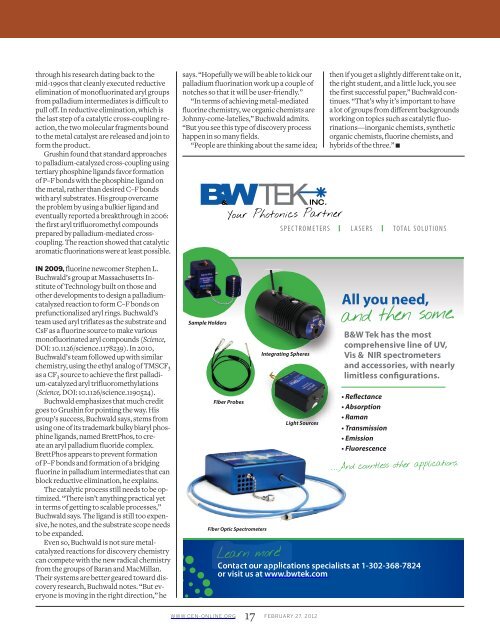February 27, 2012 - IMM@BUCT
February 27, 2012 - IMM@BUCT
February 27, 2012 - IMM@BUCT
You also want an ePaper? Increase the reach of your titles
YUMPU automatically turns print PDFs into web optimized ePapers that Google loves.
through his research dating back to the<br />
mid-1990s that cleanly executed reductive<br />
elimination of monofluorinated aryl groups<br />
from palladium intermediates is difficult to<br />
pull off. In reductive elimination, which is<br />
the last step of a catalytic cross-coupling reaction,<br />
the two molecular fragments bound<br />
to the metal catalyst are released and join to<br />
form the product.<br />
Grushin found that standard approaches<br />
to palladium-catalyzed cross-coupling using<br />
tertiary phosphine ligands favor formation<br />
of P–F bonds with the phosphine ligand on<br />
the metal, rather than desired C–F bonds<br />
with aryl substrates. His group overcame<br />
the problem by using a bulkier ligand and<br />
eventually reported a breakthrough in 2006:<br />
the first aryl trifluoromethyl compounds<br />
prepared by palladium-mediated crosscoupling.<br />
The reaction showed that catalytic<br />
aromatic fluorinations were at least possible.<br />
IN 2009, fluorine newcomer Stephen L.<br />
Buchwald ’s group at Massachusetts Institute<br />
of Technology built on those and<br />
other developments to design a palladiumcatalyzed<br />
reaction to form C–F bonds on<br />
prefunctionalized aryl rings. Buchwald’s<br />
team used aryl triflates as the substrate and<br />
CsF as a fluorine source to make various<br />
monofluorinated aryl compounds ( Science,<br />
DOI: 10.1126/science.1178239 ). In 2010,<br />
Buchwald’s team followed up with similar<br />
chemistry, using the ethyl analog of TMSCF 3<br />
as a CF 3 source to achieve the first palladium-catalyzed<br />
aryl trifluoromethylations<br />
( Science, DOI: 10.1126/science.1190524 ).<br />
Buchwald emphasizes that much credit<br />
goes to Grushin for pointing the way. His<br />
group’s success, Buchwald says, stems from<br />
using one of its trademark bulky biaryl phosphine<br />
ligands, named BrettPhos, to create<br />
an aryl palladium fluoride complex.<br />
BrettPhos appears to prevent formation<br />
of P–F bonds and formation of a bridging<br />
fluorine in palladium intermediates that can<br />
block reductive elimination, he explains.<br />
The catalytic process still needs to be optimized.<br />
“There isn’t anything practical yet<br />
in terms of getting to scalable processes,”<br />
Buchwald says. The ligand is still too expensive,<br />
he notes, and the substrate scope needs<br />
to be expanded.<br />
Even so, Buchwald is not sure metalcatalyzed<br />
reactions for discovery chemistry<br />
can compete with the new radical chemistry<br />
from the groups of Baran and MacMillan.<br />
Their systems are better geared toward discovery<br />
research, Buchwald notes. “But everyone<br />
is moving in the right direction,” he<br />
says. “Hopefully we will be able to kick our<br />
palladium fluorination work up a couple of<br />
notches so that it will be user-friendly.”<br />
“In terms of achieving metal-mediated<br />
fluorine chemistry, we organic chemists are<br />
Johnny-come-latelies,” Buchwald admits.<br />
“But you see this type of discovery process<br />
happen in so many fields.<br />
“People are thinking about the same idea;<br />
4BNQMF)PMEFST<br />
Your Photonics Partner<br />
'JCFS1SPCFT<br />
'JCFS0QUJD4QFDUSPNFUFST<br />
Learn more!<br />
then if you get a slightly different take on it,<br />
the right student, and a little luck, you see<br />
the first successful paper,” Buchwald continues.<br />
“That’s why it’s important to have<br />
a lot of groups from different backgrounds<br />
working on topics such as catalytic fluorinations—inorganic<br />
chemists, synthetic<br />
organic chemists, fluorine chemists, and<br />
hybrids of the three.” ◾<br />
SPECTROMETERS LASERS TOTAL SOLUTIONS<br />
*OUFHSBUJOH4QIFSFT<br />
-JHIU4PVSDFT<br />
All you need,<br />
and then some.<br />
B&W Tek has the most<br />
comprehensive line of UV,<br />
Vis & NIR spectrometers<br />
and accessories, with nearly<br />
limitless configurations.<br />
t3FøFDUBODF<br />
t"CTPSQUJPO<br />
t3BNBO<br />
t5SBOTNJTTJPO<br />
t&NJTTJPO<br />
t'MVPSFTDFODF<br />
. . . And countless other applications.<br />
Contact our applications specialists at 1-302-368-7824<br />
or visit us at www.bwtek.com<br />
WWW.CEN-ONLINE.ORG 17 FEBRUARY <strong>27</strong>, <strong>2012</strong>

















